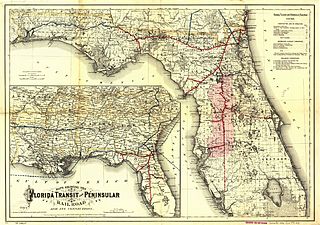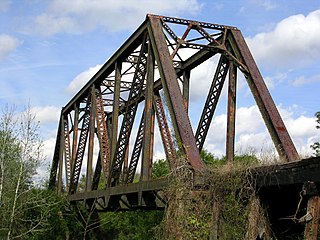
Nassau County is the northeasternmost county of the U.S. state of Florida. According to the 2010 United States Census, the county's population was 73,314. The Census Bureau estimated a population of 88,625 in 2019.

Fernandina Beach is a city in Nassau County, Florida, United States, on Amelia Island. It is the northernmost city on Florida's Atlantic coast, and is one of the principal municipalities comprising Greater Jacksonville. It is also the seat of Nassau County. The area was first inhabited by the Timucuan Indian people. Fernandina Beach is located on Amelia Island, known as the "Isle of 8 Flags", Amelia Island has had the flags of the following nations flown over it: France, Spain, Great Britain, Spain (again), the Republic of Florida, the Green Cross of Florida, Mexico, the Confederate States of America, and the United States.

Yulee is a Census county division (CCD) in Nassau County, Florida, United States. The population is currently 28,798 as of April 2018. Yulee is part of the Jacksonville metropolitan area, which was home to 1,504,980 people in 2017. Today, the Yulee CCD is a residential bedroom community for those who commute to Jacksonville, Naval Submarine Base Kings Bay, or other locations in Southeast Georgia, but is working to diversify its tax base.

David Levy Yulee was an American politician and attorney. Born in St. Thomas, then under British control, he was of Sephardi Jewish ancestry: his father was from Morocco and his mother from Europe. The family moved to Florida when he was a child, and he grew up there on their extensive lands. He later served as Florida's territorial delegate to Congress. Yulee was the first person of Jewish ancestry to be elected and serve as a United States Senator, serving 1845–1851 and again 1855–1861. He founded the Florida Railroad Company and served as president of several other companies, earning the nickname of "Father of Florida Railroads." In 2000 he was recognized as a "Great Floridian" by the state.

Amelia Island is a part of the Sea Islands chain that stretches along the East Coast of the United States from South Carolina to Florida; it is the southernmost of the Sea Islands, and the northernmost of the barrier islands on Florida's Atlantic coast. Lying in Nassau County, Florida, it is 13 miles (21 km) long and approximately 4 miles (6.4 km) wide at its widest point. The communities of Fernandina Beach, Amelia City, and American Beach are located on the island.

The Florida Central and Peninsular Railroad was the final name of a system of railroads throughout Florida, becoming part of the Seaboard Air Line Railway in 1900. The system, including some of the first railroads in Florida, stretched from Jacksonville west through Tallahassee and south to Tampa. Much of the FC&P network is still in service under the ownership of CSX Transportation.
Most CSX railroad lines are given lettered prefixes before milepost numbers. These prefixes are one to three letters long with the first letter usually refer to the former company. For instance, prefixes beginning with "S" were part of the Seaboard Air Line Railroad. Some of these company prefixes include the following:
State Road 200 is a major diagonal road in central and northeastern Florida. Its southern terminus is at US 41 in Hernando. Its northern terminus is at SR A1A in Fernandina Beach, at the corner of Atlantic Avenue and Fletcher Avenue.

The First Coast Railroad is a class III railroad operating in Florida and Georgia, owned by Genesee and Wyoming Inc. The name is derived from its area of operations around the First Coast of Florida.

The Old Gainesville Depot is a historic site at 203 Southeast Depot Avenue in Gainesville, Florida. It was added to the U.S. National Register of Historic Places on November 22, 1996. Part of the Depot was built around 1860 to serve the Florida Railroad, which reached Gainesville from Fernandina in 1859. It is one of only three surviving railroad depots in the state built prior to the start of the American Civil War. The depot was situated with tracks on both sides. Between 1892 and 1897, the depot was remodeled to provide two passenger waiting rooms, one for whites and one for Blacks. A new passenger depot with segregated waiting rooms was built in 1910, and the old depot was moved and attached as a freight house to the passenger depot. Depot operations were moved to a new building where East University Avenue crossed the rail line in January, 1948. After the railroad opened the new depot, the old depot building was used by Baird Hardware, Gator Ice and Voyles Appliance store. The City of Gainesville acquired the depot building in 1999.

The Original Town of Fernandina Historic Site, also known as "Old Town", is a historic site in Fernandina Beach, Florida, located on Amelia Island. It is roughly bounded by Towngate Street, Bosque Bello Cemetery, Nassau, Marine, and Ladies Streets. On January 29, 1990, it was added to the U.S. National Register of Historic Places as a historic site. Lying north of the Fernandina Beach Historic District, it is accessible from North 14th Street.

Joseph Finegan, sometimes Finnegan, was an Irish-born American businessman and brigadier general for the Confederate States Army during the American Civil War. From 1862 to 1864 he commanded Confederate forces operating in Middle and East Florida, ultimately leading the Confederate victory at the Battle of Olustee, the state's only major battle. He subsequently led the Florida Brigade in the Army of Northern Virginia until near the end of the war.
The Florida Railroad was the first railroad to connect the east and west coasts of Florida, running from Fernandina to Cedar Key. The line later became part of the Seaboard Air Line Railroad, and, where still in use, is operated by CSX Transportation and the First Coast Railroad. The highway corridor of SR 24, US 301, and SR A1A/SR 200 closely parallels the former Florida Railroad.
The Callahan Subdivision is a CSX Transportation railroad subdivision within the Jacksonville Division on the former Seaboard Air Line Railroad. The sub extends northward 20 miles from Baldwin, Florida, where the Jacksonville Terminal Subdivision's S Line and Florida Gulf & Atlantic Railroad meet just north of Baldwin Yard, a classification yard. According to Jacksonville Division Timetable Number 4 published in 2005, the sub runs from milepost SM 0.18 to milepost SM 20.0, where it joins the Nahunta Subdivision, a former Atlantic Coast Line Railroad, in Callahan, Florida. The line serves as a bypass to Jacksonville.

Fort San Carlos was a military structure built in 1816 to defend the Spanish colonial town of Fernandina, Florida, now called Old Town, which occupied a peninsula on the northern end of Amelia Island. The fort, a lunette fortification, stood on the southwest side of the town next to the harbor, on a bluff overlooking the Amelia River. It was made of wood and earthworks, backed with a wooden palisade on the east side, and armed with an eight or ten gun battery. Two blockhouses protected access by land on the south, while the village was surrounded with military pickets. An 1821 map of Fernandina shows that the street plan, laid out in 1811 in a grid pattern by the newly appointed Surveyor General of Spanish East Florida, George J. F. Clarke, today preserves nearly the same layout as that of 1821. The fort occupied the area bounded by the streets Calle de Estrada, Calle de White, and Calle de Someruelos. The structure itself has disappeared and only traces remain in what is now Fernandina Plaza Historic State Park.
The Port of Fernandina is located on Florida's Atlantic coast. It is used for terminal service for pulp and paper as well as steel exports, machinery, auto parts, chemicals, beverages, chemicals, building materials and food products. Container lines from the port serve routes to Colombia, Venezuela, the Dominican Republic, Haiti, Jamaica, Aruba, Curaçao and Bermuda.

Willow is a ghost town in Manatee County, Florida, United States.
The Kingsland Subdivision is a railroad line owned by CSX Transportation in Northeast Florida. The line begins in Jacksonville at a junction with the A Line near Moncrief Yard. From there, it heads east and then turns north near Panama Park. From Panama Park, the Kingsland Subdivision heads north to Yulee on a discontinuous piece of CSX's S Line. In Yulee, the line connects with the First Coast Railroad, which operates north to Seals, Georgia, on tracks that were previously part of the Kingsland Subdivision prior to 2005.
The Gross Cutoff was a rail line built by the Seaboard Air Line Railroad in northern Florida. It ran from the Seaboard Air Line Railroad’s main line at a point known as Gross to Callahan connecting two pre-existing tracks.













